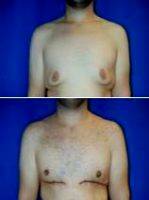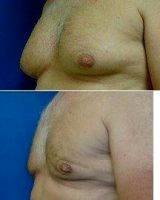Severe Gynecomastia Before And After Pictures
View Before and After Photos of Severe Gynecomastia surgery by best board certified plastic surgeons.
Severe gynecomastia (large breasts in men) can be one-sided or two-sided. There are a true and pseudo gynecomastia.
True gynecomastia occurs as a result of the growth of the glandular tissue of the breast, pseudo – due to excessive accumulation of adipose tissue in the area of the mammary glands in men.
True gynecomastia (large breasts in men) can be physiological: for example, the gynecomastia of the pubertal period develops in about half of adolescent boys and in newborns, with an excess of maternal estrogens; and senile gynecomastia associated with involutional processes in the body in men over 65 years of age.
Pathological gynecomastia is associated with a violation of estrogen metabolism. There is also the emergence of drug-caused large breasts in men, in patients receiving massive doses of oestrogens.
Severe gynecomastia develops at any age in the case of testicular pathology, their developmental anomalies – hypoplasia, cryptorchidism, testicular atrophy, for example, due to trauma, testicular tumors, as well as severe liver and kidney damage, thyroid and adrenal diseases, chromosomal diseases (Klinefelter syndrome And Wilson-Turner). There are two forms of pathological gynecomastia: diffuse and nodular.
In diffuse form, in the mammary gland appear seal movable in relation to the underlying tissues and painful to palpation.
Nodular gynecomastia (large breasts in men) is often one-sided, defined as a dense, ovoid, painless seal with distinct contours.
The diagnosis is not difficult and is based on a characteristic clinical picture and the results of determining the level of estrogens in the blood. Nodular gynecomastia must be differentiated with the early stage of breast cancer on the basis of a cytological study of the material obtained by puncturing the compaction in the mammary gland.
Treatment of a diffuse form is usually carried out by androgenic drugs, although in each specific case it is necessary to identify the cause of hormonal disorders. Treatment of the nodular form of gynecomastia is invasive.
Physiological gynecomastia does not require special treatment. With timely treatment, the prognosis is favorable.
Before And After:
- 18-24 Year Old Man Treated With Severe Gynecomastia Surgery By Doctor Brian S. Glatt, MD, FACS, Morristown Plastic Surgeon
- 18-24 Year Old Man Treated With Severe Gynecomastia Surgery By Dr Jayanthy Ravindran, MS, DNB, MRCS, India Plastic Surgeon
- 18-24 Year Old Man Treated With Severe Gynecomastia Surgery By Dr Kenneth Schimensky, MD, Dominican Republic Plastic Surgeon
- 18-24 Year Old Man Treated With Severe Gynecomastia Surgery By Dr. S. Larry Schlesinger, MD, FACS, Honolulu Plastic Surgeon
- 18-24 Year Old Man Treated With Severe Gynecomastia Surgery With Doctor Nicholas Tarola, MD, Nashville Plastic Surgeon
- 18-24 Year Old Man Treated With Severe Gynecomastia Surgery With Doctor Ritu Chopra, MD, Beverly Hills Plastic Surgeon
- 18-24 Year Old Man Treated With Severe Gynecomastia Surgery With Dr Marvin F. Shienbaum, MD, Brandon Plastic Surgeon
- 18-24 Year Old Woman Treated With Severe Gynecomastia Surgery By Dr Tom J. Pousti, MD, FACS, San Diego Plastic Surgeon
- 21 Year Old Man Treated With Male Breast Reduction By Dr. Babak Dadvand, MD, Los Angeles Plastic Surgeon
- 22 Year Male Treated For Severe Gynecomastia (male Breast Reduction) By Dr. David Shifrin, MD, Chicago Plastic Surgeon
- 22 Year Old Male Seeks Breast Reduction With Dr. Steven Vath, MD, Denver Plastic Surgeon
- 22 Year Old Man Treated With Male Breast Reduction By Dr. David K. Ward, MD, Surrey Plastic Surgeon
- 22 Year Old Man Treated With Male Breast Reduction With Dr Keshav Magge, MD, Bethesda Plastic Surgeon
- 22 Year Old Man Treated With Severe Gynecomastia Surgery By Dr. David K. Ward, MD, Surrey Plastic Surgeon
- 25-34 Year Old Man Treated With Male Breast Reduction With Dr. Robert Zubowski, MD, Paramus Plastic Surgeon
- 25-34 Year Old Man Treated With Severe Gynecomastia Surgery By Dr. Charles G. Polsen, MD, League City Plastic Surgeon
- 25-34 Year Old Man Treated With Severe Gynecomastia Surgery By Dr. Jack Peterson, MD, Topeka Plastic Surgeon
- 25-34 Year Old Man Treated With Severe Gynecomastia Surgery With Dr R. K. Mishra, MCh, DNB, India Plastic Surgeon
- 25-34 Year Old Man Treated With Severe Gynecomastia Surgery With Dr. Milan Doshi, MS, MCh, India Plastic Surgeon
- 33 Year Old Man Treated With Male Breast Reduction By Dr James N. Romanelli, MD, FACS, Long Island Plastic Surgeon
- 33 Year Old Man Treated With Male Breast Reduction Following Massive Weight Loss. With Doctor Camille Cash, MD, Houston Plastic Surgeon
- 33 Year Old Man Treated With Severe Gynecomastia Surgery By Dr James N. Romanelli, MD, FACS, Long Island Plastic Surgeon 703
- 35-44 Year Old Man Treated With Severe Gynecomastia Surgery By Doctor Leo Lapuerta, MD, Houston Plastic Surgeon
- 35-44 Year Old Man Treated With Severe Gynecomastia Surgery By Dr. Gregory D. Albert, MD, Delray Beach Plastic Surgeon
- 37 Yr Old Weight Loss Patient By Doctor Grant Stevens, MD, Los Angeles Plastic Surgeon
- 35-44 Year Old Man Treated With Severe Gynecomastia Surgery With Doctor Stephen T. Greenberg, MD, Woodbury Plastic Surgeon
- 41 Year Old Man With Male Breast Reduction By Doctor David N. Hing, MD, Ann Arbor Plastic Surgeon
- 45 Y.o. Male With Severe Gynecomastia, Desires To Have A Flatter Chest Contour With Dr Benjamin Lam, DO, FACOS, FACS, Philadelphia Plastic Surgeon
- 45-54 Year Old Man Treated With Male Breast Reduction With Doctor Francisco Sauceda, MD, Mexico Plastic Surgeon
- 45-54 Year Old Man Treated With Male Breast Reduction With Dr. Sofia K. Kirk, MD, Jacksonville Plastic Surgeon
- 45-54 Year Old Man Treated With Severe Gynecomastia Surgery With Doctor Nick Masri, MD, Miami Plastic Surgeon
- 55-64 Year Old Man Treated With Male Breast Reduction With Doctor Joseph Mlakar, MD, Fort Wayne Plastic Surgeon
- 55-64 Year Old Man Treated With Severe Gynecomastia Surgery By Doctor Gregory C. Gaines, MD, Gainesville Plastic Surgeon
- 57 Year Old Man Treated With Male Breast Reduction Before After By Doctor Carlos Mata, MD, MBA, FACS, Scottsdale Plastic Surgeon
- 57 Year Old Man Treated With Male Breast Reduction By Dr. Carlos Mata, MD, MBA, FACS, Scottsdale Plastic Surgeon
- 57 Year Old Man Treated With Male Breast Reduction With Doctor Carlos Mata, MD, MBA, FACS, Scottsdale Plastic Surgeon
- Dr Michael Law, MD, Raleigh-Durham Plastic Surgeon 35-44 Year Old Man Treated With Male Breast Reduction
- Dr Vincent D. Lepore, MD, San Jose Plastic Surgeon Severe Gynecomastia (Male Breast Reduction)
- Dr. Amy T. Bandy, DO, FACS, Newport Beach Plastic Surgeon Male Breast Reduction
- Dr. Hisham Seify, MD, PhD, FACS, Orange County Plastic Surgeon Male Breast Reduction
- Dr. Ira H. Rex Lll, MD, Fall River Plastic Surgeon Severe Gynecomastia
- Dr. J. Timothy Katzen, MD, FACS, Los Angeles Plastic Surgeon Male Breast Reduction
- Male Breast Reduction By Doctor Shlomo Widder, MD, McLean Plastic Surgeon
- Male Breast Reduction By Dr. Ven Erella, MD, Austin Plastic Surgeon
- Male Breast Reduction Severe Gynecomastia With Dr Rikesh T. Parikh, MD, Bellevue Plastic Surgeon
- Male Breast Reduction With Doctor Amy T. Bandy, DO, FACS, Newport Beach Plastic Surgeon
- Male Breast Reduction With Dr David Stoker, MD, Los Angeles Plastic Surgeon (1)
- Male Breast Reduction With Dr David Stoker, MD, Los Angeles Plastic Surgeon (2)
- Male Breast Reduction With Dr. Amy T. Bandy, DO, FACS, Newport Beach Plastic Surgeon
- Male Breasts With Doctor Farhad Rafizadeh, MD, Morristown Plastic Surgeon
- Male Severe Gynecomastia Surgery By Doctor Shlomo Widder, MD, McLean Plastic Surgeon
- Severe Gynecomastia Before And After With Dr. Richard A. Bartlett, MD, Brookline Plastic Surgeon (1)
- Severe Gynecomastia Before And After With Dr. Richard A. Bartlett, MD, Brookline Plastic Surgeon (2)
- Severe Gynecomastia By Doctor Miguel Delgado, MD, San Francisco Plastic Surgeon
- Severe Gynecomastia By Doctor Stephen E. Zucker, MD, South Bend Plastic Surgeon
- Severe Gynecomastia By Dr James F. Boynton, MD, FACS, Houston Plastic Surgeon
- Severe Gynecomastia By Dr Michael Law, MD, Raleigh-Durham Plastic Surgeon
- Severe Gynecomastia Procedure With Dr Kurtis Martin, MD, Cincinnati Plastic Surgeon
- Severe Gynecomastia Surgery With Doctor Grant Stevens, MD, Los Angeles Plastic Surgeon
- Severe Gynecomastia Surgery With Dr David Stoker, MD, Los Angeles Plastic Surgeon


